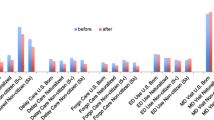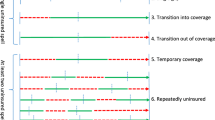Abstract
Objectives
Immigrants to the USA have disparate access to health insurance coverage and healthcare services. We evaluate the effects of gaining insurance following the January 2014 Affordable Care Act’s (ACA) key provisions implementation on health services use among foreign- (FB) and US-born (USB) adults.
Methods
Longitudinal data from two panels (2013/2014 and 2014/2015) of the Medical Expenditure Panel Survey on FB and USB adults, ages 26–64 (unweighted n = 15,232), and difference-in-differences analysis using generalized estimating equations were used to estimate the effects of insurance gain. The primary outcomes were five measures of healthcare utilization including yearly routine care appointment, annual number of physician office visits, annual number of prescription medications filled or refilled, use of the emergency department (ED) during the year, and having an inpatient hospital stay during the year.
Results
Immigrants were more likely to gain health insurance between 2013 and 2015 relative to USB adults (6.3% vs. 4.4%) but remained much more likely to be continuously uninsured by 2015 (20.8% vs. 6.4%). Controlling for sociodemographic and health characteristics, FB and USB adults who gained insurance increased their use of health services, including routine care (absolute change ΔFB = 15.7%; p < 0.001 and ΔUSB = 11.7%; p < 0.001), office-based doctor visits (ΔFB = 1.3; p < 0.001 and ΔUSB = 0.6; p < 0.001), prescribed medications (ΔFB = 2.5; p < 0.001 and ΔUSB = 1.6; p = 0.016), and inpatient hospitalizations (ΔFB = 3.6%; p = 0.017 and ΔUSB = 3%; p < 0.001). ED use increased only among the FB (ΔFB = 4.8%; p < 0.001). Gaining insurance eliminated the differences in health services use for all considered outcomes among the FB relative to the continuously insured USB.
Conclusions
US immigrants had notable gains in health insurance after the ACA provisions took full effect, but major disparities in coverage persist. If insurance continues to expand among immigrants, then the gains may reduce longstanding disparities in health services use and enhance primary and preventive healthcare.




Similar content being viewed by others
References
French MT, Homer J, Gumus G, Hickling L. Key provisions of the Patient Protection and Affordable Care Act (ACA): a systematic review and presentation of early research findings. Health Serv Res. 2016;51(5):1735–71.
Warner DC. Access to health services for immigrants in the USA: from the Great Society to the 2010 Health Reform Act and after. Ethn Racial Stud. 2012;35(1):40–55.
Sommers BD, Parmet WE. Health care for immigrants-implications of Obama’s executive action. N Engl J Med. 2015;372(13):1187–9.
Zuckerman S, Waidmann TA, Lawton E. Undocumented immigrants, left out of health reform, likely to continue to grow as share of the uninsured. Health Aff. 2011;30(10):1997–2004.
Colby LS, Ortman MJ. Projections of the size and composition of the US population: 2014 to 2060, Current Population Reports, P25–1143, U.S. Census Bureau, Washington, DC, 2014.: U.S. Census Bureau; 2015.
Carrasquillo O, Carrasquillo AI, Shea S. Health insurance coverage of immigrants living in the United States: differences by citizenship status and country of origin. Am J Public Health. 2000;90(6):917–23.
Derose KP, Escarce JJ, Lurie N. Immigrants and health care: sources of vulnerability. Health Aff. 2007;26(5):1258–68.
Derose KP, Bahney BW, Lurie N, Escarce JJ. Review: immigrants and health care access, quality, and cost. Med Care Res Rev. 2009;66(4):355–408.
Tarraf W, Miranda PY, González HM. Medical expenditures among immigrant and nonimmigrant groups in the United States: findings from the Medical Expenditures Panel Survey (2000–2008). Med Care. 2012;50(3):233–42.
Parmet WE. Holes in the safety net-legal immigrants’ access to health insurance. N Engl J Med. 2013;369(7):596–8.
Ye J, Mack D, Fry-Johnson Y, Parker K. Health care access and utilization among US-born and foreign-born Asian Americans. J Immigr Minor Health. 2012;14(5):731–7.
Goldman DP, Smith JP, Sood N. Immigrants and the cost of medical care. Health Aff. 2006;25(6):1700–11.
Tarraf W, Vega W, González HM. Emergency department services use among immigrant and non-immigrant groups in the United States. J Immigr Minor Health. 2013:1–12.
Tarraf W, Jensen GA, González HM. Impact of Medicare age eligibility on health spending among US and foreign-born adults. Health Serv Res. 2016;51(3):846–71.
Xu KT, Borders TF. Does being an immigrant make a difference in seeking physician services? J Health Care Poor Underserved. 2008;19(2):380–90.
Lebrun LA, Shi L. Nativity status and access to care in Canada and the U.S.: factoring in the roles of race/ethnicity and socioeconomic status. J Health Care Poor Underserved. 2011;22(3):1075–100.
Lebrun LA, Dubay LC. Access to primary and preventive care among foreign-born adults in Canada and the United States. Health Serv Res. 2010;45(6p1):1693–719.
Chua K-P, Sommers BD. Changes in health and medical spending among young adults under health reform. Jama. 2014;311(23):2437–9.
Antwi YA, Moriya AS, Simon K, Sommers BD. Changes in emergency department use among young adults after the Patient Protection and Affordable Care Act’s dependent coverage provision. Ann Emerg Med. 2015;65(6):664–72. e2.
Sommers BD. Why health insurance matters-and why research evidence should too. Acad Med. 2017;92:1228–30.
Sommers BD, Blendon RJ, Orav EJ, Epstein AM. Changes in utilization and health among low-income adults after Medicaid expansion or expanded private insurance. JAMA Intern Med. 2016;176(10):1501–9.
Sommers BD, Maylone B, Nguyen KH, Blendon RJ, Epstein AM. The impact of state policies on ACA applications and enrollment among low-income adults in Arkansas, Kentucky, And Texas. Health Affairs. 2015;34(6):1010–8.
Sommers BD, Maylone B, Blendon RJ, Orav EJ, Epstein AM. Three-year impacts of the affordable care act: improved medical care and health among low-income adults. Health Aff. 2017;36(6):1119–28.
Hardin JW, Hilbe JW. Generalized linear models and extensions: Stata Press books; 2012.
Fitzmaurice GM, Laird NM, Ware JH. Applied longitudinal analysis: Wiley; 2012.
Maxwell J, Cortes DE, Schneider KL, Graves A, Rosman B. Massachusetts’ health care reform increased access to care for Hispanics, but disparities remain. Health Aff (Millwood). 2011;30(8):1451–60.
Tinsley LJ, Hall SA, McKinlay JB. Has Massachusetts health care reform worked for the working poor? Results from an analysis of opportunity. Ann Epidemiol. 2014;24(4):312–8.
Benitez JA, Adams EK, Seiber EE. Did health care reform help Kentucky address disparities in coverage and access to care among the poor? Health Serv Res. 2017.
Kang YJ, McCormick D, Zallman L. Affordability of and access to information about health insurance among immigrant and non-immigrant residents after Massachusetts health reform. J Immigr Minor Health. 2017;19(4):929–38.
Davis K, Abrams M, Stremikis K. How the Affordable Care Act will strengthen the nation’s primary care foundation. J Gen Intern Med. 2011;26(10):1201–3.
Fiscella K. Health care reform and equity: promise, pitfalls, and prescriptions. Ann Fam Med. 2011;9(1):78–84.
Gold R, Bailey SR, O’Malley JP, Hoopes MJ, Cowburn S, Marino M, et al. Estimating demand for care after a Medicaid expansion: lessons from Oregon. J Ambul Care Manage. 2014;37(4):282–92.
Ku L, Jones E, Shin P, Byrne FR, Long SK. Safety-net providers after health care reform: lessons from Massachusetts. Arch Intern Med. 2011;171(15):1379–84.
Okoro CA, Dhingra SS, Coates RJ, Zack M, Simoes EJ. Effects of Massachusetts health reform on the use of clinical preventive services. J Gen Intern Med. 2014;29(9):1287–95.
Mulcahy AW, Eibner C, Finegold K. Gaining coverage through Medicaid or private insurance increased prescription use and lowered out-of-pocket spending. Health Aff (Millwood). 2016;35(9):1725–33.
Hatch B, Bailey SR, Cowburn S, Marino M, Angier H, Devoe JE. Community health center utilization following the 2008 Medicaid expansion in Oregon: implications for the Affordable Care Act. Am J Public Health. 2016;106(4):645–50.
Okoro CA, Zhao G, Fox JB, Eke PI, Greenlund KJ, Town M. Surveillance for health care access and health services use, adults aged 18–64 years-Behavioral Risk Factor Surveillance System, United States, 2014. MMWR Surveill Summ. 2017;66(7):1–42.
Martinez ME, Ward BW. Health care access and utilization among adults aged 18–64, by poverty level: United States, 2013-2015. NCHS Data Brief. 2016(262):1–8.
Courtemanche CJ, Zapata D. Does universal coverage improve health? The Massachusetts experience. J Policy Anal Manage. 2014;33(1):36–69.
Simon K, Soni A, Cawley J. The impact of health insurance on preventive care and health behaviors: evidence from the first two years of the ACA Medicaid expansions. J Policy Anal Manage. 2017;36(2):390–417.
Long SK, Stockley K, Dahlen H. Massachusetts health reforms: uninsurance remains low, self-reported health status improves as state prepares to tackle costs. Health Aff (Millwood). 2012;31(2):444–51.
Miller S. The effect of insurance on emergency room visits: an analysis of the 2006 Massachusetts health reform. J Public Econ. 2012;96(11–12):893–908.
Lee J, Ding R, Zeger SL, McDermott A, Habteh-Yimer G, Chin M, et al. Impact of subsidized health insurance coverage on emergency department utilization by low-income adults in Massachusetts. Med Care. 2015;53(1):38–44.
Niedzwiecki MJ. Does health insurance coverage encourage more efficient use of medical care? Evidence from the Massachusetts health reform. 2014.
Lasser KE, Hanchate AD, McCormick D, Manze MG, Chu C, Kressin NR. The effect of Massachusetts health reform on 30 day hospital readmissions: retrospective analysis of hospital episode statistics. BMJ. 2014;348:g2329.
Afilalo J, Marinovich A, Afilalo M, Colacone A, Léger R, Unger B, et al. Nonurgent emergency department patient characteristics and barriers to primary care. Acad Emerg Med. 2004;11(12):1302–10.
Newton MF, Keirns CC, Cunningham R, Hayward RA, Stanley R. Uninsured adults presenting to US emergency departments. JAMA. 2008;300(16):1914–24.
Zuvekas SH, Olin GL. Validating household reports of health care use in the medical expenditure panel survey. Health Serv Res. 2009;44(5p1):1679–700.
Zuvekas SH. The effects of recall length and reporting aids on household reporting of health care events in the medical expenditure panel survey. J Econ Soc Meas. 2011;36(4):321–43.
Zuvekas SH. Accuracy of Medicare expenditures in the medical expenditure panel survey. Inquiry (Chicago). 2009;46(1):92–108.
Author information
Authors and Affiliations
Corresponding author
Additional information
Publisher’s Note
Springer Nature remains neutral with regard to jurisdictional claims in published maps and institutional affiliations.
Rights and permissions
About this article
Cite this article
Tarraf, W., Jensen, G.A., Li, Y. et al. Changes in Insurance Coverage and Healthcare Use Among Immigrants and US-Born Adults Following the Affordable Care Act. J. Racial and Ethnic Health Disparities 8, 363–374 (2021). https://doi.org/10.1007/s40615-020-00790-y
Received:
Revised:
Accepted:
Published:
Issue Date:
DOI: https://doi.org/10.1007/s40615-020-00790-y




